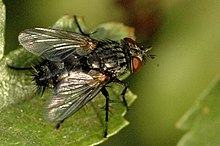Exorista larvarum
| Exorista larvarum | |
|---|---|

| |
| Exorista larvarum | |
| Scientific classification | |
| Kingdom: | |
| Phylum: | |
| Class: | |
| Order: | |
| Family: | |
| Subfamily: | |
| Tribe: | |
| Genus: | |
| Species: | E. larvarum
|
| Binomial name | |
| Exorista larvarum | |
| Synonyms[1] | |
Exorista larvarum is a Palaearctic species of fly in the family Tachinidae.[1][2]
Hosts[]
Lepidoptera larvae, mainly Lymantriidae and Lasiocampidae. It attacks Lymantria dispar dispar.[3]: 20 Studies have been conducted into its ability to successfully prey on Mythimna unipuncta[4] and Cydalima perspectalis[5].
Parasitic nature[]
It lays an egg on its host, the egg will hatch and penetrate the host.[3]: 20 The host could escape this fate by molting before the egg hatches.[3]: 20
Artificial Diets[]
For rearing Exorista larvarum in controlled conditions, inexpensive diets are preferable. MEYS contains liquid skimmed milk, chicken egg yolk, yeast extract and saccharose and HEYS contains veal homogenate, chicken egg yolk, yeast extract and saccharose.[6] Though many variations of the diet yield different results.[7] Larvae have a tendency to wander, which can result in starvation, reducing wander is important for maximizing yields.[7]
References[]
- ^ a b Chandler, Peter J. (1998). Checklists of Insects of the British Isles (New Series) Part 1: Diptera. Handbooks for the Identification of British Insects. New Series. 12. London: Royal Entomological Society of London. pp. 1–234. ISBN 0-901546-82-8.
- ^ "Fauna Europaea version 2.4". European Commission. 27 January 2011. Retrieved 11 April 2011.
- ^ a b c The Gypsy Moth: Research Toward Integrated Pest Management, United States Department of Agriculture, 1981
- ^ "Reports from University of Lleida Add New Data to Research in Biological Controls.(Report)." Life Science Weekly. NewsRX. 2012. Subscription required. Retrieved September 26, 2012 from HighBeam Research: http://www.highbeam.com/doc/1G1-297075540.html Archived 2015-09-24 at the Wayback Machine
- ^ Martini, Antonio; Di Vitantonia, Cinzia; Dindo, Maria Luisa. "Acceptance and suitability of the box tree moth Cydalima perspectalis as host for the tachinid parasitoid Exorista larvarum.". Bulletin of Insectology 72 (1): 150-160.
- ^ Chiappini, Elisabetta; Dindo, Maria Luisa; Negri, Ilaria; Sighinolfi, Luca. "In vitro rearing of Anagrus breviphragma (Hymenoptera: Mymaridae), an egg parasitoid of Cicadella viridis (Hemiptera: Cicadellidae), from second instar larva to adult on diets without insect components." European Journal of Entomology. Institute of Entomology Czech Academy of Sciences. 2004. Retrieved September 26, 2012 from HighBeam Research: http://www.highbeam.com/doc/1P3-833056621.html Archived 2018-11-20 at the Wayback Machine Subscription required.
- ^ a b MELLINI E. & CAMPADELLI G. 1995: Formulas for "inexpensive" artificial diets for the parasitoid Exorista larvarum (L.). Boll. Ist. Entomol. "Guida Grandi" Univ. Bologna 50: 95-106.http://www.bulletinofinsectology.org/pdfarticles/vol50-1996-095-106mellini.pdf
- Exoristinae
- Diptera of Europe
- Insects described in 1758
- Taxa named by Carl Linnaeus
- Exoristinae stubs